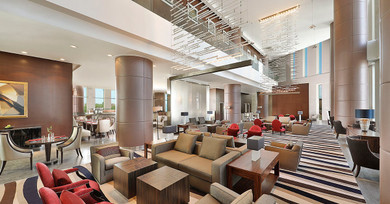Hotel Public Area Lighting
The importance of lighting in hotels cannot be overstated. Lighting is not only essential for providing functional illumination in public areas such as lobbies, corridors, and restaurants, but it also plays a crucial role in creating a warm and welcoming atmosphere that sets the tone for guests' experience. In this article, we will explore the importance of hotel public area lighting and provide insights on how to create a lighting design that enhances the guest experience.
The Importance of Hotel Public Area Lighting
Lighting can make or break the guest experience in hotels. A well-designed lighting scheme can create a welcoming atmosphere, enhance the decor and architecture, and highlight the hotel's brand identity. On the other hand, poor lighting can make the space feel gloomy, uninviting, and unappealing.
In public areas such as lobbies, restaurants, and corridors, lighting should be flexible enough to accommodate different moods and activities. For instance, in the lobby, guests may require bright lighting to check in, read a newspaper, or use their phones. However, at night, the lighting should be dimmed to create a relaxing ambiance.
Moreover, lighting can also affect the safety and security of guests. Adequate lighting in corridors and stairwells can prevent accidents and make it easier for guests to navigate their way around the hotel.
Key Considerations for Hotel Public Area Lighting
When designing lighting for hotel public areas, there are several key factors to consider. These include:
Functionality
The lighting should be functional and provide adequate illumination for guests to carry out different activities. For instance, in a restaurant, the lighting should be bright enough for guests to read the menu but dimmed enough to create a romantic ambiance during dinner.
Energy Efficiency
Energy efficiency is a crucial consideration for hotel lighting. By using energy-efficient lighting solutions such as LED lights, hotels can reduce their energy consumption and save on utility bills.
Brand Identity
Lighting can help hotels reinforce their brand identity and create a unique ambiance. For instance, a luxury hotel may use warm lighting to create a sophisticated and inviting atmosphere, while a modern hotel may use cool lighting to create a sleek and contemporary vibe.
Maintenance
The lighting should be easy to maintain and replace. This is particularly important in high-traffic areas such as lobbies and restaurants, where bulbs may need to be replaced frequently.
Lighting Design Tips for Hotel Public Areas
Here are some lighting design tips for hotel public areas:
Layered Lighting
Layered lighting involves using a combination of ambient, task, and accent lighting to create a dynamic and visually appealing space. Ambient lighting provides overall illumination, task lighting is used for specific activities such as reading or working, and accent lighting is used to highlight artwork, architectural features, or decorative objects.
Dimming Controls
Dimming controls allow guests to adjust the lighting level to their preference. This can create a more personalized experience and enhance the guest's comfort.
Color Temperature
Color temperature refers to the warmth or coolness of the light. Warm light (2700K-3000K) creates a cozy and intimate atmosphere, while cool light (4000K-5000K) creates a bright and lively ambiance. Hotels can use different color temperatures to create different moods and enhance the guest experience.
Lighting Zones
Lighting zones involve dividing the space into different areas and using different lighting solutions for each zone. This can create a more visually appealing and functional space.
Lighting Controls
Lighting controls such as occupancy sensors and timers can help hotels save energy and reduce their carbon footprint. They can also enhance the guest's experience by providing a seamless and convenient lighting solution.
Conclusion
In conclusion, hotel public area lighting is a crucial consideration for enhancing the guest experience. By considering factors such as functionality, energy efficiency, brand identity, and maintenance, hotels can create a lighting design that is visually appealing, functional, and energy-efficient. Moreover, by using lighting design tips such as layered lighting, dimming controls, color temperature, lighting zones, and lighting controls, hotels can create a unique and personalized experience for their guests.
 British Pounds
British Pounds
 Euro
Euro

